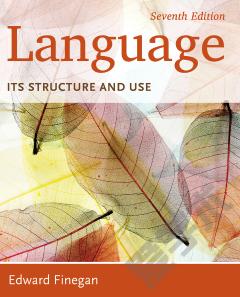Language —— Its Structure and Use
----- 语言学:结构与应用
1. Languages and Linguistics. What Do You Think? How Many Languages Are There in the World? Does the United States Have an Official Language? What Is Human Language? Signs: Arbitrary and Non-arbitrary. Languages as Patterned Structures: Grammatical Competence. Speech as Patterned Language Use: Communicative Competence. Modes of Linguistic Communication. Do Only Humans Have Language? Can Chimpanzees Learn a Human Language? The Origin of Human Languages: Babel to Babble. What Is Linguistics? Computers and Linguistics. Summary. What Do You Think? REVISITED. Exercises. Other Resources. Part 1: LANGUAGE STRUCTURES. 2. Words and Their Parts: Lexicon and Morphology. What Do You Think? Introduction: Words Seem Tangible. What Does It Mean to Know a Word? Lexical Categories. Morphemes: Word Parts with Meaning or Function. How Are Morphemes Organized Within Words? How Does a Language Increase Its Vocabulary? What Types of Morphological Systems Do Languages Have? Variant Pronunciations of a Morpheme: Allomorphy. Summary. What Do You Think? REVISITED. Exercises. Other Resources. 3. The Sounds of Languages: Phonetics. What Do You Think? Sounds and Spellings: Not the Same Thing. Phonetics: The Study of Sounds. Describing Consonant Sounds. Kinds of Consonant Sounds. Vowel Sounds. Summary. What Do You Think? REVISITED. Exercises. Other Resources. 4. Sound Systems of Language: Phonology. What Do You Think? Introduction: Sounds in the Mind. Phonological Rules and Their Structure. Syllables and Syllable Structure. Stress. Syllables and Stress in Phonological Processes. Morphology and Phonology Interaction: Allomorphy. From Lexical Entries to Surface Realizations: What the Brain Knows. Summary. What Do You Think? REVISITED. Exercises. Other Resources. 5. The Structure and Function of Phrases and Sentences: Syntax. What Do You Think? Introduction. Constituency. Major Constituents of Sentences: Noun Phrases and Verb Phrases. Phrase-Structure Expansions. Grammatical Relations: Subject, Direct Object, and Others. Surface Structures and Underlying Structures. Types of Syntactic Operations. Functions of Syntactic Operations. Recursion and Novel Sentences. Summary. What Do You Think? REVISITED. Exercises. Other Resources. 6. The Study of Meaning: Semantics. What Do You Think? Introduction. Linguistic, Social, and Affective Meaning. Word, Sentence, and Utterance Meaning. Lexical Semantics. Function Words and Categories of Meaning. Semantic Roles and Sentence Meaning. Semantic Roles and Grammatical Relations. Summary. What Do You Think? REVISITED. Exercises. Other Resources. 7. Language Universals and Language Typology. What Do You Think? Similarity and Diversity Across Languages. Phonological Universals. Syntactic and Morphological Universals. Types of Language Universals. Explanations for Language Universals. Language Universals, Universal Grammar, and Language Acquisition. Summary. What Do You Think? REVISITED. Exercises. Other Resources. Part 2: LANGUAGE USE. 8. Information Structure and Pragmatics. What Do You Think? Introduction: Encoding Information Structure. Categories of Information Structure. Information Structure: Intonation, Morphology, Syntax. The Relationship of Sentences to Discourse: Pragmatics. Summary. What Do You Think? REVISITED. Exercises. Other Resources. 9. Speech Acts and Conversation. What Do You Think? Language in Use. Sentence Structure and the Function of Utterances. Speech Acts. The Cooperative Principle. Violations of the Cooperative Principle. Politeness. Speech Events. The Organization of Conversation. Cross-Cultural Communication. Summary. What Do You Think? REVISITED. Exercises. Other Resources. 10. Language Variation Across Situations of Use: Registers and Styles. What Do You Think? Introduction. Language Varies Within a Speech Community. Speech Situations. Registers in Monolingual Societies. Similarities and Differences Between Spoken and Written Registers. Two Registers Compared. Summary. What Do You Think? REVISITED. Exercises. Other Resources. 11. Language Variation Among Social Groups: Dialects. What Do You Think? Language or Dialect: Which Do You Speak? How Do Languages Diverge and Merge? National Varieties of English. Regional Varieties of American English. The Atlas of North American English. Ethnic Varieties of American English. Ethnic Varieties and Social Identification. Socioeconomic Status Varieties: English, French, and Spanish. The Language Varieties of Women and Men. Why Do Stigmatized Varieties Persist? Summary. What Do You Think? REVISITED. Exercises. Other Resources. Part 3: LANGUAGE CHANGE, LANGUAGE DEVELOPMENT, AND LANGUAGE ACQUISITION. 12. Language Change Over Time: Historical Linguistics. What Do You Think? Do Living Languages Always Change? Language Families and the Indo-European Family. How to Reconstruct the Linguistic Past. What Are the Language Families of the World? .Languages in Contact. Summary. What Do You Think? REVISITED. Exercises. Other Resources. 13. Historical Development in English. What Do You Think? Old English: 700-1100. Companions of Angels: A Narrative in Old English. Middle English: 1100-1500. Where Men and Women Go All Naked: A Middle English Travel Fable. Modern English: 1500-Present. Summary. What Do You Think? REVISITED. Exercises. Other Resources. 14. Acquiring First and Second Languages. What Do You Think? Introduction. Acquiring a First Language. How Do Researchers Study Language Acquisition? Acquiring a Second Language. Summary. What Do You Think? REVISITED. Exercises. Other Resources. Glossary. Index. Index of Languages. Index of Internet Sites, Films, and Videos. Credits.
{{comment.content}}








 京公网安备 11010802027623号
京公网安备 11010802027623号